Antiplatelet and anticoagulant drugs for prevention of restenosis/reocclusion following peripheral endovascular treatment
- PMID: 22895926
- PMCID: PMC7066628
- DOI: 10.1002/14651858.CD002071.pub3
Antiplatelet and anticoagulant drugs for prevention of restenosis/reocclusion following peripheral endovascular treatment
Abstract
Background: Peripheral arterial disease (PAD) is frequently treated by balloon angioplasty. Restenosis/reocclusion of the dilated segments occurs often, depending on length of occlusion, lower leg outflow, stage of disease and presence of cardiovascular risk factors. To prevent reocclusion, patients are treated with antithrombotic agents. This is an update of a review first published in 2005.
Objectives: To determine whether any antithrombotic drug is more effective in preventing restenosis or reocclusion after peripheral endovascular treatment, compared to another antithrombotic drug, no treatment, placebo or other vasoactive drugs.
Search methods: For this update the Cochrane Peripheral Vascular Diseases Group Trials Search Co-ordinator searched the Specialised Register (last searched 14 February 2012) and CENTRAL (2012, Issue 1).
Selection criteria: We selected randomised controlled trials (RCTs). Participants were patients with symptomatic PAD treated by endovascular revascularisation of the pelvic or femoropopliteal arteries. Interventions were anticoagulant, antiplatelet or other vasoactive drug therapy compared with no treatment, placebo or any other vasoactive drug. Clinical endpoints were reocclusion, restenosis, amputation, death, myocardial infarction, stroke, major bleeding and other side effects, such as minor bleeding, puncture site bleeding, gastrointestinal side effects and haematoma.
Data collection and analysis: We independently extracted and assessed details of the number of randomised patients, treatment, study design, patient characteristics and risk of bias. Analysis was based on intention-to-treat data. To examine the effects of outcomes such as reocclusion, restenosis, amputation and major bleeding, we computed odds ratios (OR) with 95% confidence intervals (CI) using a fixed-effect model.
Main results: Twenty-two trials with a total of 3529 patients are included (14 in the original review and a further eight in this update). For the majority of comparisons, only one trial was available so results were rarely combined in meta-analyses. Individual trials were generally small and risk of bias was often unclear due to limitations in reporting. Three trials reported on drug versus placebo/control; results were consistently available for a maximum follow-up of only six months. At six months post intervention, a statistically significant reduction in reocclusion was found for high-dose acetylsalicylic acid (ASA) combined with dipyridamole (DIP) (OR 0.40, 95% CI 0.19 to 0.84), but not for low-dose ASA combined with DIP (OR 0.69, 95% CI 0.44 to 1.10; P = 0.12) nor in major amputations for lipo-ecraprost (OR 0.89, 95% CI 0.44 to 1.80). The remaining trials compared different drugs; results were more consistently available for a longer period of 12 months. At 12 months post intervention, no statistically significant difference in reocclusion/restenosis was detected for any of the following comparisons: high-dose ASA versus low-dose ASA (OR 0.98, 95% CI 0.64 to 1.48; P = 0.91), ASA/DIP versus vitamin K antagonists (VKA) (OR 0.65, 95% CI 0.40 to 1.06; P = 0.08), clopidogrel and aspirin versus low molecular weight heparin (LMWH) plus warfarin (OR 0.31, 95% CI 0.06 to 1.68; P = 0.18), suloctidil versus VKA: reocclusion (OR 0.59, 95% CI 0.20 to 1.76; P = 0.34), restenosis (OR 1.87, 95% CI 0.66 to 5.31; P = 0.24) and ticlopidine versus VKA (OR 0.71, 95% CI 0.37 to 1.36; P = 0.30). Treatment with cilostazol resulted in statistically significantly fewer reocclusions than ticlopidine (OR 0.32, 95% CI 0.13 to 0.76; P = 0.01). Compared with aspirin alone, LMWH plus aspirin significantly decreased occlusion/restenosis (by up to 85%) in patients with critical limb ischaemia (OR 0.15, 95% CI 0.06 to 0.42; P = 0.0003) but not in patients with intermittent claudication (OR 1.73, 95% CI 0.97 to 3.08; P = 0.06) and batroxobin plus aspirin reduced restenosis in diabetic patients (OR 0.28, 95% CI 0.13 to 0.60). Data on bleeding and other potential gastrointestinal side effects were not consistently reported, although there was some evidence that high-dose ASA increased gastrointestinal side effects compared with low-dose ASA, that clopidogrel and aspirin resulted in fewer major bleeding episodes compared with LMWH plus warfarin, and that abciximab resulted in more severe bleeding episodes.
Authors' conclusions: There is limited evidence suggesting that restenosis/reocclusion at six months following peripheral endovascular treatment is reduced by use of antiplatelet drugs compared with placebo/control, but associated information on bleeding and gastrointestinal side effects is lacking. There is also some evidence of variation in effect according to different drugs with cilostazol reducing reocclusion/restenosis at 12 months compared with ticlopidine and both LMWH and batroxobin combined with aspirin appearing beneficial compared with aspirin alone. However, available trials are generally small and of variable quality and side effects of drugs are not consistently addressed. Further good quality, large-scale RCTs, stratified by severity of disease, are required.
Conflict of interest statement
None known.
Figures
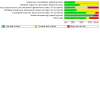
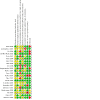
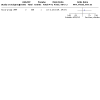
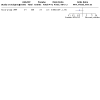

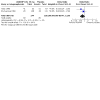
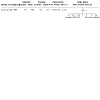
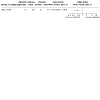
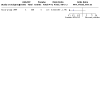

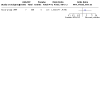
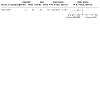
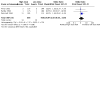
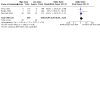
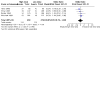
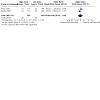
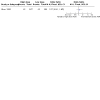
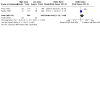
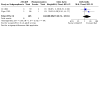
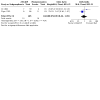
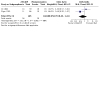
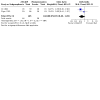
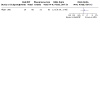
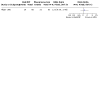
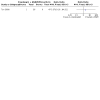
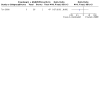
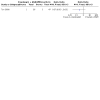
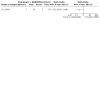
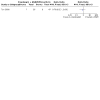
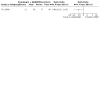
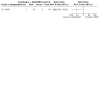
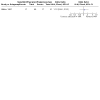
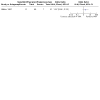
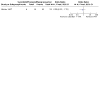
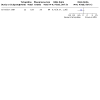

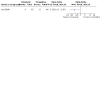


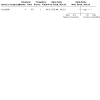
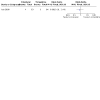

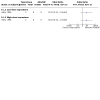
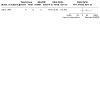
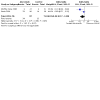
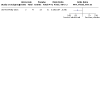
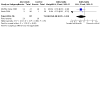
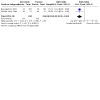
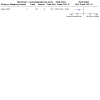


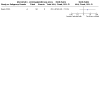
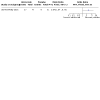
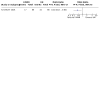
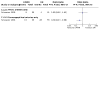

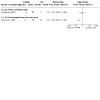

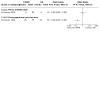
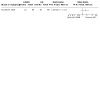
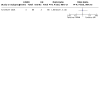
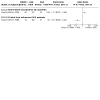
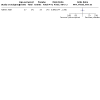
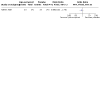
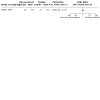
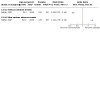
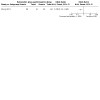
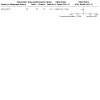
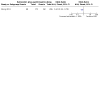
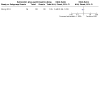
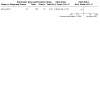

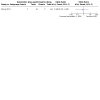
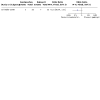
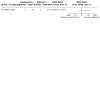
Update of
-
Antiplatelet and anticoagulant drugs for prevention of restenosis/reocclusion following peripheral endovascular treatment.Cochrane Database Syst Rev. 2005 Jan 25;(1):CD002071. doi: 10.1002/14651858.CD002071.pub2. Cochrane Database Syst Rev. 2005. Update in: Cochrane Database Syst Rev. 2012 Aug 15;(8):CD002071. doi: 10.1002/14651858.CD002071.pub3. PMID: 15674891 Updated.
Comment in
-
Evidence from Cochrane systematic reviews for effects of antithrombotic drugs for lower-limb revascularization. A narrative review.Sao Paulo Med J. 2021 Aug 13;139(6):675-684. doi: 10.1590/1516-3180.2020.0640.110321. eCollection 2021. Sao Paulo Med J. 2021. PMID: 34406310 Free PMC article.
References
References to studies included in this review
Ansel 2006 {published data only}
-
- Ansel GM, Silver MJ, Botti CF Jr, Rocha-Singh K, Bates MC, Rosenfield K, et al. Functional and clinical outcomes of nitinol stenting with and without abciximab for complex superficial femoral artery disease: a randomized trial. Catheterization and Cardiovascular Interventions 2006;67(2):288-97. - PubMed
Baumgartner 2007 {published data only}
-
- Baumgartner I. Reopro and peripheral arterial intervention to improve clinical outcome in patients with peripheral arterial disease (RIO Trial). Clinical Research in Cardiology 2007;96(11):783-4.
Do 1994 {published data only}
-
- Do DD, Mahler F. Low-dose aspirin combined with dipyridamole versus anticoagulants after femoropopliteal percutaneous transluminal angioplasty. Radiology 1994;193(2):567-71. - PubMed
Dörffler‐Melly 2005 {published data only}
-
- Dörffler-Melly J, Mahler F, Do DD, Triller J, Baumgartner I. Adjunctive abciximab improves patency and functional outcome in endovascular treatment of femoropopliteal occlusions: initial experience. Radiology 2005;237(3):1103-9. - PubMed
Duda 2001 {published data only}
-
- Duda SH, Tepe G, Luz O, Ouriel K, Dietz K, Hahn U, et al. Peripheral artery occlusion: treatment with abciximab plus urokinase versus with urokinase alone--a randomized pilot trial (the PROMPT Study). Platelet Receptor Antibodies in Order to Manage Peripheral Artery Thrombosis. Radiology 2001;221(3):689-96. - PubMed
Heinz 1996 {published data only}
-
- Heinz M, Theiss W, de Flierdt E, Söhngen M. The effect of Taprostene on platelet activation and clinical course after percutaneous transluminal angioplasty [Der Einfluss von Taprosten auf Thrombozytenaktivierung und klinischen Verlauf nach perkutaner transluminaler Angioplastie]. Vasa 1996;25(1):65-72. - PubMed
Heiss 1990 {published data only}
-
- Heiss HW, Just H, Middleton D, Deichsel G. Reocclusion prophylaxis with dipyridamole combined with acetylsalicylic acid following PTA. Angiology 1990;41(4):263-9. - PubMed
Hess 1978 {published data only}
-
- Hess H, Müller-Fassbender H, Ingrisch H, Mietaschk A. Prevention of re-occlusion after recanalisation of occluded arteries by the catheter method (author's transl) [Verhütung von Wiederverschlüssen nach Rekanalisation obliterierter Arterien mit der Kathetermethode]. Deutsche Medizinische Wochenschrift 1978;103(50):1994-7. - PubMed
Iida 2008 {published data only}
-
- Iida O, Nanto S, Uematsu M, Morozumi T, Kitakaze M, Nagata S. Cilostazol reduces restenosis after endovascular therapy in patients with femoropopliteal lesions. Journal of Vascular Surgery 2008;48(1):144-9. - PubMed
Koppensteiner 2006 {published data only}
-
- Koppensteiner R, Spring S, Amann-Vesti BR, Meier T, Pfammatter T, Rousson V, et al. Low-molecular-weight heparin for prevention of restenosis after femoropopliteal percutaneous transluminal angioplasty: a randomized controlled trial. Journal of Vascular Surgery 2006;44(6):1247-53. - PubMed
Mahler 1987 {published data only}
-
- Mahler F, Schneider E, Gallino A, Bollinger A. Combination of suloctidil and anticoagulation in the prevention of reocclusion after femoropopliteal PTA. Vasa 1987;16(4):381-5. - PubMed
Minar 1995 {published data only}
-
- Minar E, Ahmadi A, Koppensteiner R, Maca T, Stümpflen A, Ugurluoglu A, et al. Comparison of effects of high-dose and low-dose aspirin on restenosis after femoropopliteal percutaneous transluminal angioplasty. Circulation 1995;91(8):2167-73. - PubMed
Nehler 2007 {published data only}
-
- Nehler MR, Brass EP, Anthony R, Dormandy J, Jiao J, McNamara TO, et al. Adjunctive parental therapy with lipo-ecraprost, a prostaglandin E1 analog, in patients with critical limb ischemia undergoing distal revascularization does not improve 6-month outcomes. Journal of Vascular Surgery 2007;45(5):953-61. - PubMed
Pilger 1991 {published data only}
-
- Pilger E, Lammer J, Bertuch H, Stark G, Decrinis M, Pfeiffer KP, et al. Nd:YAG laser with sapphire tip combined with balloon angioplasty in peripheral arterial occlusions. Long-term results. Circulation 1991;83(1):141-7. - PubMed
Ranke 1994 {published data only}
-
- Creutzig A, Ranke C, Luska G, Wagner HH, Galanski M, Bode Boger S, et al. Controlled trial of high versus low dose aspirin treatment after PTA in patients with peripheral vascular disease. Annals of Hematology 1994;68(Suppl 1):A74. - PubMed
-
- Ranke C, Creutzig A, Luska G, Wagner HH, Galanksi M, Bode-Böger S, et al. Controlled trial of high-versus low-dose aspirin treatment after percutaneous transluminal angioplasty in patients with peripheral vascular disease. Clinical Investigator 1994;72(9):673-80. - PubMed
-
- Ranke C, Creutzig A, Luska G, Wagner HH, Galanskî M, Bode-Böger S, et al. Dose-dependent side effects of acetylsalicylic acid therapy. Results of a prospective randomized clinical study in patients with peripheral arterial occlusive disease [Dosisabhängige Nebenwirkungen der Acetylsalicylsäuretherapie]. Medizinische Klinische 1993;88(10):571-6. - PubMed
-
- Ranke C, Hecker H, Creutzig A, Alexander K. Aspirin dose and progression of peripheral vascular disease: results of a controlled clinical trial. Annals of Hematology 1994;68(Suppl 1):A74.
Schindler 2008 {published data only}
-
- Schindler C, Mueller A, Bramlage P, Boecking W, Kirch W, Schweizer J. Comparison of selective AT1- receptor blockade versus ACE inhibition for restenosis prophylaxis in patients with peripheral occlusive arterial disease after stent angioplasty: a randomized, controlled, proof-of-concept study. Angiology 2008;58(6):710-6. - PubMed
Schneider 1987 {published data only}
-
- Schneider E, Mahler F, Do DD, Biland l, Widmer LK, Bollinger A. Zur Rezidivprophylaxe nach perkutaner transluminaler Angioplastie (PTA): Antikoagulation versus Ticlopidin. Vasa 1987;16(Suppl 20):355-6.
Schweizer 2001 {published data only}
-
- Schweizer J, Müller A, Forkmann L, Hellner G, Kirch W. Potential use of a low-molecular-weight heparin to prevent restenosis in patients with extensive wall damage following peripheral angioplasty. Angiology 2001;52(10):659-69. - PubMed
Study group 1994 {published data only}
-
- Study group on pharmacological treatment after PTA. Platelet inhibition with ASA/dipyridamole after percutaneous balloon angioplasty in patients with symptomatic lower limb arterial disease. A prospective double-blind trial. European Journal of Vascular Surgery 1994;8(1):83-8. - PubMed
Tan 2008 {published data only}
-
- Tan JY, Shi WH, He J, Zhu L, Wang TP, Yu B. A clinical trial of using antiplatelet therapy to prevent restenosis following peripheral artery angioplasty and stenting [Chinese]. National Medical Journal of China 2008;88(12):812-5. - PubMed
Wang 2011 {published data only}
-
- Wang J, Zhu YQ, Li MH, Zhao JG, Tan HQ, Wang JB, et al. Batroxobin plus aspirin reduces restenosis after angioplasty for arterial occlusive disease in diabetic patients with lower-limb ischemia. Journal of Vascular and Interventional Radiology 2011;22(7):987-94. - PubMed
-
- Wang J, Zhu YQ, Liu F, Li MH, Zhao JG, Tan HQ, et al. Batroxobin for prevention of restenosis in diabetic patients after infrapopliteal arterial angioplasty: a small randomized pilot trial. Annals of Vascular Surgery 2010;24(7):876-84. - PubMed
Weichert 1994 {published data only}
-
- Weichert W, Meents H, Abt K, Lieb H, Hach W, Krzywanek HJ, et al. Acetylsalicylic acid--reocclusion--prophylaxis after angioplasty (ARPA-study). A randomized double-blind trial of two different dosages of ASA in patients with peripheral occlusive arterial disease. Vasa 1994;23(1):57-65. - PubMed
References to studies excluded from this review
Allie 2003 {published data only}
-
- Allie DE, Lirtzman MD, Wyatt CH, Keller VA, Khan MH, Khan MA, et al. Bivalirudin as a foundation anticoagulant in peripheral vascular disease: a safe and feasible alternative for renal iliac interventions. Journal of Invasive Cardiology 2003;15(6):334-42. - PubMed
Bulvas 1996 {published data only}
-
- Bulvas M, Chochola M, Herdova J, Sommerova Z, Urbanova R. The effect of heparin sulphate on percutaneous transluminal angioplasty in the vessels supplying the lower extremities [Vliv heparansulfatu na efekt perkutanni transluminalni angioplastiky v oblasti tepen zasobujicich dolni koncetiny]. Casopis Lekaru Ceskych 1996;135(14):445-9. - PubMed
Horrocks 1997 {published data only}
-
- Horrocks M, Horrocks EH, Murphy P, Lane IF, Ruttley MS, Fligelstone LJ, et al. The effects of platelet inhibitors on platelet uptake and restenosis after femoral angioplasty. International Angiology 1997;16(2):101-6. - PubMed
Ishii 2008 {published data only}
Mueller 1997 {published data only}
-
- Mueller MR, Salat A, Stangl P, Murabito M, Pulaki S, Boehm D, et al. Variable platelet response to low-dose ASA and the risk of limb deterioration in patients submitted to peripheral arterial angioplasty. Thrombosis and Haemostasis 1997;78(3):1003-7. - PubMed
Shammas 2003 {published data only}
-
- Shammas NW, Lemke JH, Dippel EJ, McKinney DE, Takes VS, Youngblut M, et al. Bivalirudin in peripheral vascular interventions: a single center experience. Journal of Invasive Cardiology 2003;15(7):401-4. - PubMed
Stavropoulos 2003 {published data only}
-
- Stavropoulos SW, Solomon JA, Soulen MC, Clark TW, Shlansky-Goldberg RD. Use of abciximab during infrainguinal peripheral vascular interventions: initial experience. Radiology 2003;227(3):657-61. - PubMed
Strecker 2004 {published data only}
-
- Strecker EP, Boos IB, Gottmann D, Vetter S. Clopidogrel plus long-term aspirin after femoro-popliteal stenting. The CLAFS project: 1- and 2-year results. European Radiology 2004;14(2):302-8. - PubMed
Tetteroo 1995 {published data only}
-
- Tetteroo E, Mali WP, Rienks R, Kester JA, Banga JD. The significance of coumarin anticoagulation in laser assisted percutaneous transluminal angioplasty of femoropopliteal arterial obstructions. European Journal of Radiology 1995;19(2):86-90. - PubMed
Zeitler 1973 {published data only}
-
- Zeitler E, Reichold J, Schoop W, Loew D. Effect of acetylsalicylic acid on early results following percutaneous recanalisation of arterial occlusions (Dotter's method) [Einfluss von Acetylsalicylsäure auf das Frühergebnis nach perkutaner Rekanalisation arterieller Obliterationen nach Dotter]. Deutsche Medizinische Wochenschrift 1973;98(26):1285-8. - PubMed
References to ongoing studies
Mirror 2011 {published data only}
-
- Mirror trial - follow-up management of peripheral arterial intervention with clopidogrel. http://clinicaltrials.gov/ct2/show/NCT00163267 (accessed 2 May 2012).
Additional references
Block 1981
-
- Block PC, Myler RK, Stertzer S, Fallon JT. Morphology after transluminal angioplasty in human beings. New England Journal of Medicine 1981;305(7):382-5. - PubMed
CAMPER
-
- Sanofi-Aventis. Press releases. http://en.sanofi-aventis.com/press/ppc_17142.asp (accessed 27 September 2004).
CURE 2003
-
- Peters RJ, Mehta SR, Fox KA, Zhao F, Lewis BS, Kopecky SL, et al. Effects of aspirin dose when used alone or in combination with clopidogrel in patients with acute coronary syndromes: observations from the Clopidogrel in Unstable angina to prevent Recurrent Events (CURE) study. Circulation 2003;108(14):1682-7. - PubMed
Decrinis 1993
-
- Decrinis M, Pilger E, Stark G, Lafer M, Obernosterer A, Lammer J. A simplified procedure for intra-arterial thrombolysis with tissue-type plasminogen activator in peripheral arterial occlusive disease: primary and long-term results. European Heart Journal 1993;14(3):297-305. - PubMed
Do 1992
-
- Do DD, Triller J, Walpoth BH, Stirnemann P, Mahler F. A comparison study of self-expandable stents vs balloon angioplasty alone in femoropopliteal artery occlusions. Cardiovascular and Interventional Radiology 1992;15(5):306-12. - PubMed
Dotter 1964
-
- Dotter CT, Judkins MP. Transluminal treatment of arteriosclerotic obstruction. Description of a new technic and a preliminary report of its application. Circulation 1964;30:654-70. - PubMed
Duda 2002
-
- Duda SH, Pusich B, Richter G, Landwehr P, Oliva VL, Tielbeek A, et al. Sirolimus-eluting stents for the treatment of obstructive superficial femoral artery disease: six-month results. Circulation 2002;106(12):1505-9. - PubMed
Ellis 1989
-
- Ellis SG, Roubin GS, Wilentz J, Douglas JS Jr, King SB III. Effect of 18- to 24-hour heparin administration for prevention of restenosis after uncomplicated coronary angioplasty. American Heart Journal 1989;117(4):777-82. - PubMed
Ferns 1992
-
- Ferns GAA, Stewart-Lee AL, Anggard EE. Arterial response to mechanical injury: balloon catheter de-endothelialization. Atherosclerosis 1992;92(2-3):89-104. - PubMed
Fontaine 1954
-
- Fontaine VR, Kim M, Kieny R. Surgical treatment for peripheral vascular disease [Die chirurgische Behandlung der peripheren Durchblutungsstorungen]. Helvetica Chirurgica Acta 1954;5/6:499-533. - PubMed
Fuster 1995
-
- Fuster V, Falk E, Fallon JT, Badimon L, Chesebro JH, Badimon JJ. The three processes leading to post PTCA restenosis: dependence on the lesion substrate. Thrombosis and Haemostasis 1995;74(1):552-9. - PubMed
Gallino 1984
-
- Gallino A, Mahler F, Probst P, Nachbur B. Percutaneous transluminal angioplasty of the arteries of the lower limbs: a 5 year follow-up. Circulation 1984;70(4):619-23. - PubMed
Grüntzig 1974
-
- Grüntzig A, Hopff H. Percutaneous recanalization after chronic arterial occlusion with a new dilator-catheter (modification of the Dotter technique). Deutsche Medizinische Wochenschrift 1974;99(49):2502-10, 2511. - PubMed
Haudenschild 1995
-
- Haudenschild CC. Pathophysiology of reocclusion and restenosis. Fibrinolysis 1995;9(Suppl 1):44-7.
Hess 1985
-
- Hess H, Mietaschk A, Deichsel G. Drug-induced inhibition of platelet function delays progression of peripheral arterial occlusive disease. A prospective double-blind arteriographically controlled trial. Lancet 1985;1(8426):415-9. - PubMed
Higgins 2011
-
- Higgins JPT, Green S (editors). Cochrane Handbook for Systematic Reviews of Interventions Version 5.1.0 [updated March 2011]. The Cochrane Collaboration, 2011. Available from www.cochrane-handbook.org.
Jadad 1996
-
- Jadad AR, Moore RA, Carroll D, Jenkinson C, Reynolds DJM, Gavaghan DJ, et al. Assessing the quality of reports of randomised clinical trials: is blinding necessary? Controlled Clinical Trials 1996;17(1):1-12. - PubMed
Jorgensen 1990
-
- Jorgensen B, Meisner S, Holstein P, Tonnesen KH. Early rethrombosis in femoropopliteal occlusions treated with percutaneous transluminal angioplasty. European Journal of Vascular Surgery 1990;4(2):149-52. - PubMed
Mahler 1999
-
- Mahler F, Baumgartner I, Do DD. Stenting of the peripheral, renal and supraaortic arteries and the aorta. Schweizerische Medizinische Wochenschrift 1999;129(10):399-409. - PubMed
Mewissen 2004
-
- Mewissen MW. Self-expanding nitinol stents in the femoropopliteal segment: technique and mid-term results. Techniques in Vascular and Interventional Radiology 2004;7(1):2-5. - PubMed
Minar 2000
-
- Minar E, Pokrajac B, Maca T, Ahmadi R, Fellner C, Mittlbock M, et al. Endovascular brachytherapy for prophylaxis of restenosis after femoropopliteal angioplasty: results of a prospective randomized study. Circulation 2000;102(22):2694-9. - PubMed
Moneta 1987
-
- Moneta GL, Strandness DE Jr. Peripheral arterial duplex scanning. Journal of Clinical Ultrasound 1987;15(9):645-51. - PubMed
Palmaz 1985
-
- Palmaz JC, Sibbitt RR, Reuter SR, Tio FO, Rice WJ. Expandable intraluminal graft: a preliminary study. Work in progress. Radiology 1985;156(1):73-7. - PubMed
Parent 1989
-
- Parent FN 3rd, Bernhard VM, Pabst TS 3rd, McIntyre KE, Hunter GC, Malone JM. Fibrinolytic treatment of residual thrombus after catheter embolectomy for severe lower limb ischemia. Journal of Vascular Surgery 1989;9(1):153-60. - PubMed
Ranke 1992
-
- Ranke C, Creutzig A, Alexander K. Duplex scanning of the peripheral arteries: correlation of the peak velocity ratio with angiographic diameter reduction. Ultrasound in Medicine and Biology 1992;18(5):433-40. - PubMed
RevMan 2011 [Computer program]
-
- Review Manager (RevMan). Version 5.1. Copenhagen: The Nordic Cochrane Centre, The Cochrane Collaboration, 2011.
Rutherford 2001
-
- Rutherford RB, Baker JD, Ernst C, Johnston KW, Porter JM, Ahn S, et al. Recommended standards for reports dealing with lower extremity ischemia: revised version. Journal of Vascular Surgery 2001;33(4):805. - PubMed
Sabeti 2004
-
- Sabeti S, Schillinger M, Amighi J, Sherif C, Mlekusch W, Ahmadi R, et al. Primary patency of femoropopliteal arteries treated with nitinol versus stainless steel self-expanding stents: propensity score-adjusted analysis. Radiology 2004;232(2):516-21. - PubMed
Schillinger 2003
-
- Schillinger M, Mlekusch W, Haumer M, Sabeti S, Ahmadi R, Minar E. Angioplasty and elective stenting of de novo versus recurrent femoropopliteal lesions: 1-year follow-up. Journal of Endovascular Therapy 2003;10(2):288-97. - PubMed
Schneider 1989
-
- Schneider E. Percutaneous transluminal angioplasty, local thrombolysis and percutaneous thrombus extraction in the treatment of arterial occlusions of the extremities [Die perkutane transluminale Angioplastie, lokale Thrombolyse und perkutane Thrombenextraktion in der Behandlung von Extremitäten Arterienverschlüssen]. Der Internist 1989;30(7):440-6. - PubMed
Schwartz 1998
-
- Schwartz RS. Pathophysiology of restenosis: interaction of thrombosis, hyperplasia, and/or remodeling. American Journal of Cardiology 1998;81(7 Suppl 1):14E-17E. - PubMed
Shammas 2003b
-
- Shammas NW, Lemke JH, Dippel EJ, McKinney DE, Takes VS, Youngblut M, et al. In-hospital complications of peripheral vascular interventions using unfractionated heparin as the primary anticoagulant. Journal of Invasive Cardiology 2003;15(5):242-6. - PubMed
Strecker 1988
-
- Strecker EP, Berg G, Schneider B, Freudenberg N, Weber H, Wolf RD. A new vascular balloon-expandable prosthesis. Experimental studies and first clinical results. Journal of Interventional Radiology 1988;3(2):59-62.
TASC 2000
-
- Trans Atlantic Inter-Society Consensus (TASC). Management of peripheral arterial disease. Treatment of intermittent claudication. Journal of Vascular Surgery 2000;31(1 Pt 2):S97-113.
Tsakiris 1999
-
- Tsakiris DA, Tschöpl M, Jäger K, Haefeli WE, Wolf F, Marbet GA. Circulating cell adhesion molecules and endothelial markers before and after transluminal angioplasty in peripheral arterial occlusive disease. Atherosclerosis 1999;142(1):193-200. - PubMed
Tschöpl 1997
-
- Tschöpl M, Tsakiris DA, Marbet GA, Labs KH, Jaeger K. Role of haemostatic risk factors for restenosis in peripheral arterial occlusive disease after transluminal angioplasty. Arteriosclerosis, Thrombosis and Vascular Biology 1997;17(11):3208-14. - PubMed
Vogel 2003
-
- Vogel TR, Shindelman LE, Nackman GB, Graham AM. Efficacious use of nitinol stents in the femoral and popliteal arteries. Journal of Vascular Surgery 2003;38(6):1178-84. - PubMed
Ward 2001
-
- Ward MR, Tsao PS, Agrotis A, Dilley RJ, Jennings GL, Bobik A. Low blood flow after angioplasty augments mechanisms of restenosis: inward vessel remodeling, cell migration, and activity of genes regulating migration. Arteriosclerosis, Thrombosis and Vascular Biology 2001;21(2):208-13. - PubMed
Watson 2000
-
- Watson HR, Bergqvist D. Antithrombotic agents after peripheral transluminal angioplasty: a review of the studies, methods and evidence for their use. European Journal of Vascular and Endovascular Surgery 2000;19(5):445-50. - PubMed
Wentzel 2003
-
- Wentzel JJ, Gijsen FJ, Stergiopulos N, Serruys PW, Slager CJ, Krams R. Shear stress, vascular remodeling and neointimal formation. Journal of Biomechanics 2003;36(5):681-8. - PubMed
Zehnder 2000
-
- Zehnder T, Birrer M, Do DD, Baumgartner I, Triller J, Nachbur B, et al. Percutaneous catheter thrombus aspiration for acute or subacute arterial occlusion of the legs: how much thrombolysis is needed? European Journal of Vascular and Endovascular Surgery 2000;20(1):41-6. - PubMed
References to other published versions of this review
Dörffler‐Melly 2005
-
- Dörffler-Melly J, Koopmann MMW, Adam DJ, Prins MH, Büller HR. Prevention of early occlusion in symptomatic PAOD patients undergoing peripheral catheter intervention. Cochrane Database of Systematic Reviews 2005, Issue 1. Art. No: CD002071. [DOI: 10.1002/14651858.CD002071.pub2] - DOI
Publication types
MeSH terms
Substances
Grants and funding
LinkOut - more resources
Full Text Sources
Other Literature Sources
Medical

